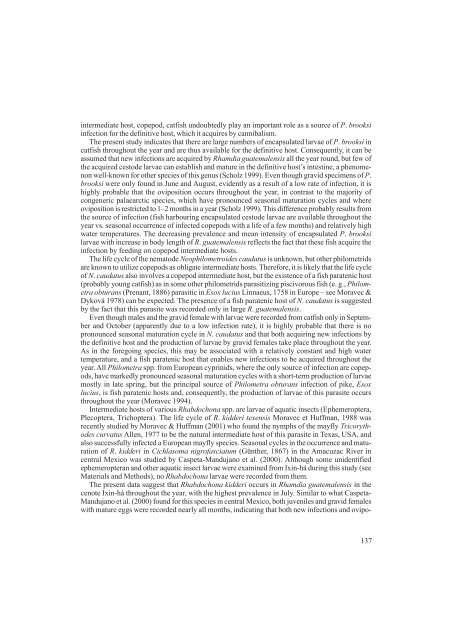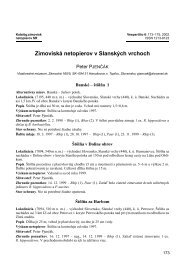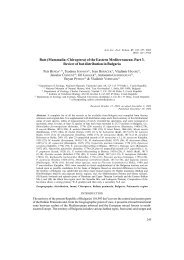Gyraulus parvus (Mollusca: Gastropoda) in the Czech Republic
Gyraulus parvus (Mollusca: Gastropoda) in the Czech Republic
Gyraulus parvus (Mollusca: Gastropoda) in the Czech Republic
- No tags were found...
Create successful ePaper yourself
Turn your PDF publications into a flip-book with our unique Google optimized e-Paper software.
<strong>in</strong>termediate host, copepod, catfish undoubtedly play an important role as a source of P. brooksi<strong>in</strong>fection for <strong>the</strong> def<strong>in</strong>itive host, which it acquires by cannibalism.The present study <strong>in</strong>dicates that <strong>the</strong>re are large numbers of encapsulated larvae of P. brooksi <strong>in</strong>catfish throughout <strong>the</strong> year and are thus available for <strong>the</strong> def<strong>in</strong>itive host. Consequently, it can beassumed that new <strong>in</strong>fections are acquired by Rhamdia guatemalensis all <strong>the</strong> year round, but few of<strong>the</strong> acquired cestode larvae can establish and mature <strong>in</strong> <strong>the</strong> def<strong>in</strong>itive host’s <strong>in</strong>test<strong>in</strong>e, a phenomenonwell-known for o<strong>the</strong>r species of this genus (Scholz 1999). Even though gravid specimens of P.brooksi were only found <strong>in</strong> June and August, evidently as a result of a low rate of <strong>in</strong>fection, it ishighly probable that <strong>the</strong> oviposition occurs throughout <strong>the</strong> year, <strong>in</strong> contrast to <strong>the</strong> majority ofcongeneric palaearctic species, which have pronounced seasonal maturation cycles and whereoviposition is restricted to 1–2 months <strong>in</strong> a year (Scholz 1999). This difference probably results from<strong>the</strong> source of <strong>in</strong>fection (fish harbour<strong>in</strong>g encapsulated cestode larvae are available throughout <strong>the</strong>year vs. seasonal occurrence of <strong>in</strong>fected copepods with a life of a few months) and relatively highwater temperatures. The decreas<strong>in</strong>g prevalence and mean <strong>in</strong>tensity of encapsulated P. brooksilarvae with <strong>in</strong>crease <strong>in</strong> body length of R. guatemalensis reflects <strong>the</strong> fact that <strong>the</strong>se fish acquire <strong>the</strong><strong>in</strong>fection by feed<strong>in</strong>g on copepod <strong>in</strong>termediate hosts.The life cycle of <strong>the</strong> nematode Neophilometroides caudatus is unknown, but o<strong>the</strong>r philometridsare known to utilize copepods as obligate <strong>in</strong>termediate hosts. Therefore, it is likely that <strong>the</strong> life cycleof N. caudatus also <strong>in</strong>volves a copepod <strong>in</strong>termediate host, but <strong>the</strong> existence of a fish paratenic host(probably young catfish) as <strong>in</strong> some o<strong>the</strong>r philometrids parasitiz<strong>in</strong>g piscivorous fish (e. g., Philometraobturans (Prenant, 1886) parasitic <strong>in</strong> Esox lucius L<strong>in</strong>naeus, 1758 <strong>in</strong> Europe – see Moravec &Dyková 1978) can be expected. The presence of a fish paratenic host of N. caudatus is suggestedby <strong>the</strong> fact that this parasite was recorded only <strong>in</strong> large R. guatemalensis.Even though males and <strong>the</strong> gravid female with larvae were recorded from catfish only <strong>in</strong> Septemberand October (apparently due to a low <strong>in</strong>fection rate), it is highly probable that <strong>the</strong>re is nopronounced seasonal maturation cycle <strong>in</strong> N. caudatus and that both acquir<strong>in</strong>g new <strong>in</strong>fections by<strong>the</strong> def<strong>in</strong>itive host and <strong>the</strong> production of larvae by gravid females take place throughout <strong>the</strong> year.As <strong>in</strong> <strong>the</strong> forego<strong>in</strong>g species, this may be associated with a relatively constant and high watertemperature, and a fish paratenic host that enables new <strong>in</strong>fections to be acquired throughout <strong>the</strong>year. All Philometra spp. from European cypr<strong>in</strong>ids, where <strong>the</strong> only source of <strong>in</strong>fection are copepods,have markedly pronounced seasonal maturation cycles with a short-term production of larvaemostly <strong>in</strong> late spr<strong>in</strong>g, but <strong>the</strong> pr<strong>in</strong>cipal source of Philometra obturans <strong>in</strong>fection of pike, Esoxlucius, is fish paratenic hosts and, consequently, <strong>the</strong> production of larvae of this parasite occursthroughout <strong>the</strong> year (Moravec 1994).Intermediate hosts of various Rhabdochona spp. are larvae of aquatic <strong>in</strong>sects (Ephemeroptera,Plecoptera, Trichoptera). The life cycle of R. kidderi texensis Moravec et Huffman, 1988 wasrecently studied by Moravec & Huffman (2001) who found <strong>the</strong> nymphs of <strong>the</strong> mayfly Tricorythodescurvatus Allen, 1977 to be <strong>the</strong> natural <strong>in</strong>termediate host of this parasite <strong>in</strong> Texas, USA, andalso successfully <strong>in</strong>fected a European mayfly species. Seasonal cycles <strong>in</strong> <strong>the</strong> occurrence and maturationof R. kidderi <strong>in</strong> Cichlasoma nigrofasciatum (Gün<strong>the</strong>r, 1867) <strong>in</strong> <strong>the</strong> Amacuzac River <strong>in</strong>central Mexico was studied by Caspeta-Mandujano et al. (2000). Although some unidentifiedephemeropteran and o<strong>the</strong>r aquatic <strong>in</strong>sect larvae were exam<strong>in</strong>ed from Ix<strong>in</strong>-há dur<strong>in</strong>g this study (seeMaterials and Methods), no Rhabdochona larvae were recorded from <strong>the</strong>m.The present data suggest that Rhabdochona kidderi occurs <strong>in</strong> Rhamdia guatemalensis <strong>in</strong> <strong>the</strong>cenote Ix<strong>in</strong>-há throughout <strong>the</strong> year, with <strong>the</strong> highest prevalence <strong>in</strong> July. Similar to what Caspeta-Mandujano et al. (2000) found for this species <strong>in</strong> central Mexico, both juveniles and gravid femaleswith mature eggs were recorded nearly all months, <strong>in</strong>dicat<strong>in</strong>g that both new <strong>in</strong>fections and ovipo-137








